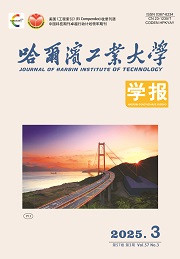| 引用本文: | 王汉鹏,张冰,张玉军,吴宝杨,武洋,李鹏,王鹏.地下水库典型岩体全应力应变过程碎胀储水特性[J].哈尔滨工业大学学报,2025,57(3):120.DOI:10.11918/202307048 |
| WANG Hanpeng,ZHANG Bing,ZHANG Yujun,WU Baoyang,WU Yang,LI Peng,WANG Peng.Broken expansion and water storage characteristics of underground reservoir typical rock in complete stress-strain process[J].Journal of Harbin Institute of Technology,2025,57(3):120.DOI:10.11918/202307048 |
|
| |
|
|
| 本文已被:浏览 36次 下载 69次 |

码上扫一扫! |
|
|
| 地下水库典型岩体全应力应变过程碎胀储水特性 |
|
王汉鹏1,2,3,张冰1,2,3,张玉军1,4,吴宝杨1,武洋1,李鹏1,王鹏3
|
|
(1.煤炭开采水资源保护与利用国家重点实验室,北京 102209;2.山东大学 岩土与地下工程研究院,济南 250061; 3.山东大学 齐鲁交通学院,济南 250061;4.神华神东安全监察局,内蒙古 鄂尔多斯 017200)
|
|
| 摘要: |
| 为探明开采过程中采空区典型岩体碎胀储水演化特性及内在机制,基于自主研发的岩石三轴流固耦合试验系统推导了岩样碎胀、储水系数同步测试方法,针对粗砂岩、粉砂岩和泥岩开展了三轴加载岩样全应力应变过程碎胀储水系数测定试验,并采用核磁共振成像同步获取了岩石内部裂隙空间分布情况。结果表明:3类岩样的碎胀、储水系数随加载进程逐渐增大并趋于稳定,对应应力应变曲线4个阶段呈阶段性梯度变化。其中,储水系数随着应变变化呈现较好的双参数Weibull分布。初始孔隙度在一定程度上影响着新生裂隙扩展形态及岩样储水空间,随着岩样初始孔隙度增大,储水系数在峰前80%及以前呈线性增大关系,之后呈指数增大关系。基于碎胀系数计算的储水系数理论值和试验实测值演化规律一致但数值具有明显差异,最大差值可达0.7%,具有明显的“先碎胀后储水”特征。岩样的碎胀、储水系数受应力加载与初始孔隙度的耦合影响,在加载初期由初始孔隙度主导,逐渐过渡至应力主导,最终由应力及岩体孔裂隙贯穿程度共同决定。 |
| 关键词: 地下水库 顶板覆岩 全应力应变过程 碎胀系数 储水特性 |
| DOI:10.11918/202307048 |
| 分类号:TD74 |
| 文献标识码:A |
| 基金项目:煤炭开采水资源保护与利用国家重点实验室开放基金(WPUKFJJ2019-07);国家能源集团科技创新项目(GJNY-18-80) |
|
| Broken expansion and water storage characteristics of underground reservoir typical rock in complete stress-strain process |
|
WANG Hanpeng1,2,3,ZHANG Bing1,2,3,ZHANG Yujun1,4,WU Baoyang1,WU Yang1,LI Peng1,WANG Peng3
|
|
(1.State Key Laboratory of Water Resource Protection and Utilization in Coal Mining, Beijing 102209, China; 2.Institute of Geotechnical and Underground Engineering, Shandong University, Jinan 250061, China; 3.School of Qilu Transportation, Shandong University, Jinan 250061, China; 4.Shenhua Shendong Safety Supervision Bureau, Ordos 017200, Inner Mongolia, China)
|
| Abstract: |
| To explore the broken expansion and water storage evolution characteristics and internal mechanism of typical rock masses in goafs during mining, a synchronous test method of broken expansion coefficient and water storage coefficient based on a self-developed rock triaxial fluid-solid coupling test system was developed. A triaxial loading test was conducted on rock samples of coarse sandstone, siltstone, and mudstone to determine the broken expansion and water storage coefficients in complete stress-strain process, and the spatial distribution of internal fractures in the rock was synchronously obtained via nuclear magnetic resonance imaging. The results show that the broken expansion and water storage coefficients of the three types of rock samples gradually increase and tend to stabilize with the loading process, and the corresponding stress-strain curve shows a phased gradient change in four stages. Among them, the water storage coefficient exhibits a good Weibull distribution with strain variation. The initial porosity affects the expansion morphology of newly formed fractures and the water storage space of rock samples to some extent. As the initial porosity of rock samples increases, the water storage coefficient shows a linear increasing relationship before 80% prepeak, and then an exponential increasing relationship. The theoretical value of the water storage coefficient calculated based on the expansion coefficient is consistent with the evolution law of the experimental measured value, but the difference in value can reach up to 0.7%, indicating a clear characteristic of first broken expansion followed by water storage. The broken expansion and water storage coefficient of rock samples are influenced by the coupling effect of stress loading and initial porosity. In the initial stage of loading, the initial porosity dominates, gradually transitioning to stress dominance, and is ultimately determined by both stress and the degree of penetration of rock pores and fractures. |
| Key words: underground reservoir roof overburden complete stress-strain process broken expansion coefficient water storage characteristics |
|
|
|
|







